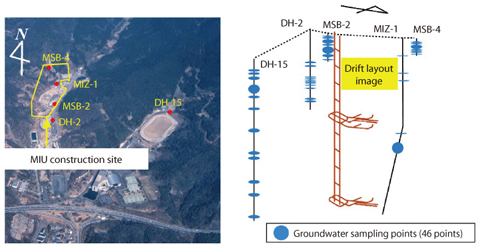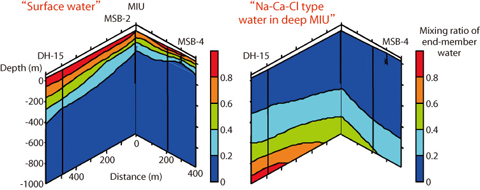
Fig.2-16 Bird's-eye view of MIU construction site and borehole location,
and groundwater sampling point in each borehole.

Fig.2-17 Mixing ratios of end-member water named "Surface water" and "High salinity Na-Ca-Cl water in deeper part of MIU" (Cross section of Fig.2-16).
The Japanese government has decided that the radioactive waste from atomic power plants shall be isolated in deep underground deeper than 300m below ground level. The construction and operation of such a large facility causes various environmental disturbances around it. For example, the pump up of large amounts of groundwater will change the hydraulic and chemical condition of groundwater in the local area.
This study focuses on methodology development to estimate long-term hydrochemical disturbance by a large underground facility. The analysis of principal components together with mixture and mass balance calculations was carried out at Mizunami Underground Research Laboratory (MIU: Fig.2-16) to infer the hydrochemical condition and evolution processes of groundwater prior to facility construction. The results show that the groundwater in the local area evolves by a mixing process among four end-component water types ("surface water", "Na-Ca-HCO3 type water" , "dilute Na-Ca-Cl type water in shallow part of MIU" reaction and precipitation / dissolution. The dominant evolution process in the vicinity of MIU is considered to be mixing between "dilute Na-Ca-Cl type water in shallow part of MIU" and "concentrated Na-Ca-Cl type water in deep part of MIU". It is possible to quantitatively describe the groundwater chemistry by the mixing ratio of the end components (Fig.2-17).
Furthermore, we attempted quantitative analysis of hydrochemical changes of groundwater around MIU during construction based on continuous hydrochemical observation. Preliminary analysis indicates that the hydrochemical change occurred several tens to several hundreds meter from the drift. This disturbed area will expand with time. Disturbance may be caused by inflow of large amounts of groundwater into drift, followed by outflow.
The procedure and methodology demonstrated by this study enable production of a "snap shot" of the hydrochemical condition at every step of facility construction. Such analysis will provide an important insight regarding disturbances around an underground facility.